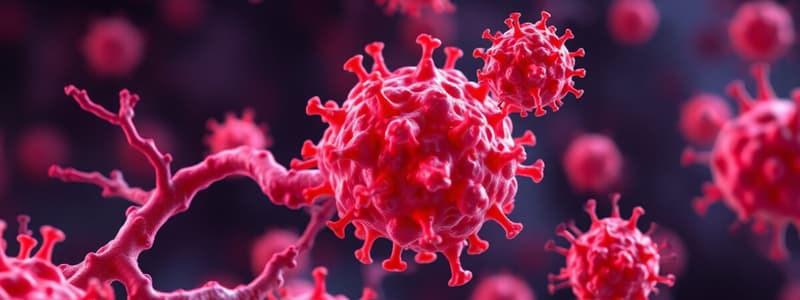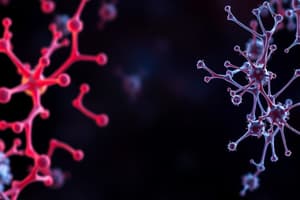Podcast
Questions and Answers
Given the temporal dynamics of immune responses, what is the MOST critical implication of a delayed adaptive immune onset in the context of a rapidly progressing, highly virulent bacterial infection?
Given the temporal dynamics of immune responses, what is the MOST critical implication of a delayed adaptive immune onset in the context of a rapidly progressing, highly virulent bacterial infection?
- Enhanced recruitment of neutrophils to the site of infection, potentiating innate immune clearance.
- Prolonged window of opportunity for exponential bacterial proliferation, potentially overwhelming innate defenses. (correct)
- Diminished likelihood of immunologic memory formation, necessitating repeated booster vaccinations.
- Abrogation of complement cascade activation, leading to increased susceptibility to opportunistic pathogens.
A patient presents with a novel immunodeficiency characterized by a fully functional adaptive immune system but a severely compromised complement activation pathway. Which of the following pathogens would MOST likely pose the greatest threat to this patient?
A patient presents with a novel immunodeficiency characterized by a fully functional adaptive immune system but a severely compromised complement activation pathway. Which of the following pathogens would MOST likely pose the greatest threat to this patient?
- Fungi, due to the absence of TH17 activation.
- Helminth parasites, due to ineffective IgE-mediated degranulation.
- Encapsulated bacteria, due to reduced opsonization and phagocytosis. (correct)
- Intracellular viruses, due to impaired cytotoxic T lymphocyte activity.
In a scenario where an individual is exposed to a previously encountered pathogen, yet exhibits a blunted adaptive immune response, which of the following mechanisms is the LEAST likely contributing factor?
In a scenario where an individual is exposed to a previously encountered pathogen, yet exhibits a blunted adaptive immune response, which of the following mechanisms is the LEAST likely contributing factor?
- Impaired antigen presentation by dendritic cells due to dysfunctional MHC Class II expression.
- Compromised T cell receptor (TCR) signaling as a result of inhibitory checkpoint receptor engagement.
- Defective somatic hypermutation in B cells leading to low-affinity antibody production.
- Enhanced NK cell activity leading to rapid depletion of the pathogen. (correct)
Consider a hypothetical immunomodulatory drug that selectively enhances the duration, but not the magnitude, of the innate immune response. What potential adverse consequence should be MOST carefully monitored in clinical trials?
Consider a hypothetical immunomodulatory drug that selectively enhances the duration, but not the magnitude, of the innate immune response. What potential adverse consequence should be MOST carefully monitored in clinical trials?
A research team is investigating a novel adjuvant designed to bridge innate and adaptive immunity more effectively. Which of the following mechanisms would represent the MOST promising target for achieving this goal?
A research team is investigating a novel adjuvant designed to bridge innate and adaptive immunity more effectively. Which of the following mechanisms would represent the MOST promising target for achieving this goal?
In a scenario where an individual exhibits a genetic mutation leading to a complete absence of functional Toll-like receptors (TLRs) on innate immune cells, which of the following immunological consequences would be the MOST detrimental?
In a scenario where an individual exhibits a genetic mutation leading to a complete absence of functional Toll-like receptors (TLRs) on innate immune cells, which of the following immunological consequences would be the MOST detrimental?
Considering the interplay between innate and adaptive immunity, what would be the MOST significant consequence of a therapeutic intervention that selectively depletes dendritic cells (DCs) in a patient with an established chronic infection?
Considering the interplay between innate and adaptive immunity, what would be the MOST significant consequence of a therapeutic intervention that selectively depletes dendritic cells (DCs) in a patient with an established chronic infection?
A researcher discovers a novel pathogen that elicits a strong innate immune response characterized by excessive inflammation but fails to induce a robust adaptive immune response. Which of the following mechanisms would be the MOST plausible explanation for this phenomenon?
A researcher discovers a novel pathogen that elicits a strong innate immune response characterized by excessive inflammation but fails to induce a robust adaptive immune response. Which of the following mechanisms would be the MOST plausible explanation for this phenomenon?
In the context of vaccine development, what strategy would MOST effectively leverage the innate immune system to enhance the efficacy of a subunit vaccine (composed of purified microbial antigens)?
In the context of vaccine development, what strategy would MOST effectively leverage the innate immune system to enhance the efficacy of a subunit vaccine (composed of purified microbial antigens)?
A patient with a rare genetic disorder exhibits a hyperactive innate immune system, characterized by constitutively elevated levels of inflammatory cytokines. Paradoxically, this patient is unusually susceptible to intracellular bacterial infections. Which of the following mechanisms BEST explains this seemingly contradictory phenotype?
A patient with a rare genetic disorder exhibits a hyperactive innate immune system, characterized by constitutively elevated levels of inflammatory cytokines. Paradoxically, this patient is unusually susceptible to intracellular bacterial infections. Which of the following mechanisms BEST explains this seemingly contradictory phenotype?
Flashcards
Innate Immunity
Innate Immunity
The first cellular line of defense, providing an immediate, non-specific response that remains constant across multiple infections.
Adaptive Immunity
Adaptive Immunity
A specific and adaptable defense mechanism that improves over time, creating immunological memory for long-lasting protection.
Major Components of Innate Immunity
Major Components of Innate Immunity
Physical and chemical barriers, phagocytosis, and complement activation.
Link Between Innate and Adaptive Immunity
Link Between Innate and Adaptive Immunity
Signup and view all the flashcards
Role of Physical Barriers
Role of Physical Barriers
Signup and view all the flashcards
Innate Immune Response Timeline
Innate Immune Response Timeline
Signup and view all the flashcards
Adaptive Immune Response Timeline
Adaptive Immune Response Timeline
Signup and view all the flashcards
Study Notes
- Innate immunity serves as the body's initial cellular defense mechanism against invading microorganisms.
- The immune response of innate immunity is immediate and remains consistent across multiple infections.
- Adaptive immunity enhances over time, offering specific immunity.
- Adaptive immunity employs diverse antibodies for immunological memory and long-term protection
- Onset duration and immune protection duration are key factors determining the benefits and limitations of the two immune system branches.
- Innate immunity responds in minutes to hours.
- Adaptive immunity takes days to weeks to respond.
- Innate immunity has limited specificity to microorganisms.
- Adaptive immunity improves during disease progression.
- Innate immunity components include physical and chemical barriers, phagocytosis, and complement activation.
- Innate immunity connects to adaptive immunity via T cells.
- T cells lead to the development of antibodies or humoral and cellular immune responses.
Patient Immune Response to Disease Progression
- Physical barriers provide immediate and significant protection.
- Innate immune response develops rapidly but declines after several hours.
- Adaptive immunity intersects the decline of innate immunity.
- Adaptive immunity onset is delayed, its protection level is significant and prolonged.
- Consider clinical implications when innate or adaptive immunity and associated mechanisms are impaired.
- Consider the duration of onset or protection in an immunocompromised person.
Studying That Suits You
Use AI to generate personalized quizzes and flashcards to suit your learning preferences.


